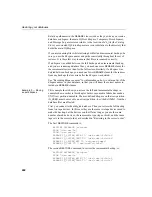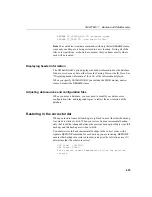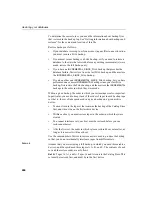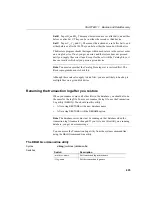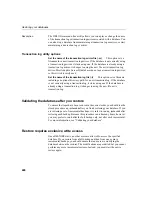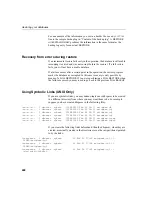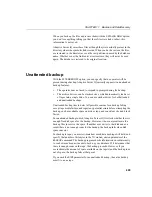
Determining your data backup and recovery strategy
416
Eliminating data verification
You can also improve the speed of backup and restore operations by setting
CRC OFF
in the
BACKUP
command. This setting deactivates cyclical
redundancy checking. With
CRC ON
, numbers computed on backup are
verified during any subsequent restore operation, affecting performance of
both commands. The default is
CRC ON
. If you turn off this checking,
remember that you are giving up a greater assurance of accurate data in
exchange for faster performance.
Spooling backup data
You may find that it is faster and more efficient to create backups on disk, and
then spool them onto tape for archival storage. If you choose this approach, you
need to unspool the data onto disk before restoring it.
Increasing memory used during backup
The amount of memory used for buffers during backup directly affects backup
speed, primarily for tape backups. The
BLOCK FACTOR
parameter of the
BACKUP
command controls the amount of memory used. If your backups are
slow, you may want to increase the value of
BLOCK FACTOR
for faster
backups.
The effect of
BLOCK FACTOR
depends on your operating system, and on the
block size specified when the database was created. By default, the database
block size is 4096.
On UNIX, the default
BLOCK FACTOR
is 25. With this combination,
BACKUP
is able to buffer data ideally for most UNIX tape drives, with enough data in
memory that drives are kept busy constantly throughout the backup.
On Windows NT, the default
BLOCK FACTOR
is computed based on the
database block size. This value usually achieves maximum throughput on NT.
Because of the way NT handles tape devices, you may not be able to achieve
faster backups by increasing the
BLOCK FACTOR
.
Balancing system load
Adaptive Server IQ allows you to perform backups concurrently with all other
read/write operations, except those that affect the structure of the database. It
is still a good idea to schedule backups during times of low system use,
however, to make the best possible use of system resources—disk, memory,
and CPU cycles.
Summary of Contents for Adaptive Server IQ 12.4.2
Page 1: ...Administration and Performance Guide Adaptive Server IQ 12 4 2 ...
Page 16: ...xvi ...
Page 20: ...Related documents xx ...
Page 40: ...Compatibility with earlier versions 20 ...
Page 118: ...Troubleshooting startup shutdown and connections 98 ...
Page 248: ...Importing data by replication 228 ...
Page 306: ...Integrity rules in the system tables 286 ...
Page 334: ...Cursors in transactions 314 ...
Page 396: ...Users and permissions in the system tables 376 ...
Page 438: ...Determining your data backup and recovery strategy 418 ...
Page 484: ...Network performance 464 ...
Page 500: ...System utilities to monitor CPU use 480 ...
Page 514: ...Characteristics of Open Client and jConnect connections 494 ...
Page 536: ...Index 516 ...

